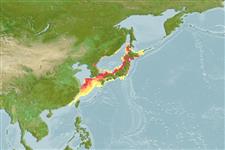Environment: milieu / climate zone / depth range / distribution range
पारिस्थितिकी
समुद्री ड़िमरसल; गहराई सीमा 15 - 269 m (Ref. 58496). Boreal
Northwest Pacific: Japan and the Sea of Okhotsk.
आकार / वज़न / Age
Maturity: Lm ? range ? - ? cm
Max length : 44.0 cm TL पुल्लिंग / अलिंग; (Ref. 56527); common length : 31.5 cm TL पुल्लिंग / अलिंग; (Ref. 56557); अधिकतम प्रकाशित वज़न: 1.0 kg (Ref. 56527)
पृष्ठीय रीढ़ (सम्पूर्ण): 9 - 10; पृष्ठीय सौफट रेज़ (सम्पूर्ण): 14-17; गुदा कांटा 0; ऐनल सौफट रेज़: 13 - 16
Life cycle and mating behavior
परिपक्व अवधि | पुनरुत्पत्ति | मछलीऔ का अंडे देना | अंडे | Fecundity | लार्वा
External fertilization with internal insemination (Ref. 101419). This is also called 'internal gametic association' which describes another unique phenomenon of the reproductive process. In this phenomenon, the presence of the spermatozoa in the ovarian cavity is done through copulation, but the spermatozoa entry into the egg and subsequent fertilization only occurred externally when the eggs are spawned and came into contact with seawater (Ref. 101419).
Nakabo, T., 2002. Fishes of Japan with pictorial keys to the species, English edition I. Tokai University Press, Japan, pp v-866. (Ref. 41299)
IUCN Red List Status (Ref. 130435)
Threat to humans
Harmless
Human uses
अधिक जानकारी
संदर्भजलीयकृषिजलीयकृषि रूपरेखाखींचआनुवंशिकीElectrophoresesहैरेटिबिलटीबीमारीप्रक्रमणNutrientsMass conversion
सहयोगीयोतस्वीरेStamps, Coins Misc.ध्वनिसिगुयटिरारफ्तारतैरने के प्रकारगिल क्षेत्रOtolithsदिमागदृष्टि
साधन
Special reports
Download XML
इंटरनेट स्रोत
Estimates based on models
Preferred temperature (Ref.
123201): 3.6 - 17.3, mean 12.9 °C (based on 37 cells).
Phylogenetic diversity index (Ref.
82804): PD
50 = 1.0000 [Uniqueness, from 0.5 = low to 2.0 = high].
Bayesian length-weight: a=0.00676 (0.00300 - 0.01523), b=3.17 (2.98 - 3.36), in cm total length, based on LWR estimates for this (Sub)family-body shape (Ref.
93245).
Trophic level (Ref.
69278): 3.6 ±0.4 se; based on diet studies.
लौटाव (Ref.
120179): बहुत नीचे, न्यूनतम जनसंख्या दुगनी समय अवलागत 14 महीने। (Preliminary K or Fecundity.).
Fishing Vulnerability (Ref.
59153): Low to moderate vulnerability (34 of 100).
